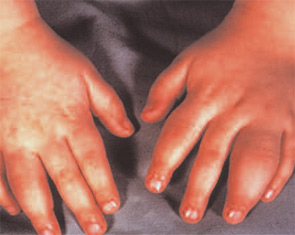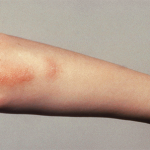All children should have documented negative tuberculosis (TB) skin tests before starting any biologic therapy, and live vaccines are contraindicated while patients are receiving biologic therapy.

Anti-TNF Agents
TNF blockers have been documented to be very effective treatments for JIA. Prospective investigations have been done on patients with polyarticular course of disease with oligo, poly, or systemic onset.
By three months of treatment with these agents, most children will have responded if they are going to do so. Continued improvement with longer treatment has been reported. Doses are generally as follows:
- Etanercept: 0.8 mg/kg/wk;
- Infliximab: 6-10 mg/kg/infusion (usually monthly until full response, then lengthened if tolerated to every eight weeks); and
- Adalimumab: 24 mg/m2 every two weeks.
The most common side effects are injection-site or infusion reactions and upper respiratory-tract infections. Etanercept use for as long as eight years has been reported with no increase in serious infections and no reports of lupus, malignancy, demyelinating disorders, or death.
Anakinra
Anti-IL1 blockade appears to be uniquely effective for children with systemic JIA. The adult dose is 100 mg subcutaneously daily, and reports in children have used 1–2.8 mg/kg/day. The main side effect is injection-site reaction, with burning and pain. This decreases in the second month, according to reports. Incidence of infections does not appear to be greater than in placebo populations.
Abatacept
Abatacept (Orencia) is given as an IV infusion monthly at a dose of 10 mg/kg. Infusion reactions are mild and include dizziness, nausea, or headache, with rare reports of hypotension or hypersensitivity. Mild infections were the most common side effect reported, with some reports of severe infections and two reports of suspected TB. Abatacept has been demonstrated to be effective for JIA polyarthritis with 49% of children achieving ACR pedi-30 improvement.
Rituximab
The most common regimen is 750 mg/m2 (1-gram maximum) intravenously twice, two weeks apart. Infusion reactions are usually mild, but there have been reports of serum sickness after the second dose. Side effects may be lessened by pretreatment with benadryl, acetaminophen, and solumedrol.
It may be best to boost tetanus immunity and also immunize for meningococcus and pneumococcus two to three weeks before starting rituximab (even though patients on MTX and prednisone may not respond well to these immunizations). Some clinicians recommend prevention of serious infection with intravenous immunoglobulin 400 mg/month for at least a year post-treatment, because total immunoglobulin levels are not a reliable indicator of adequacy of response to infection or the ability to respond to an antigenic challenge in patients with rheumatologic diseases who are treated with rituximab.
